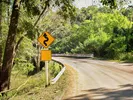10 Most Dangerous Roads in the U.S.
When you must drive on one of the worst roads in America
Roads have connected places all over the U.S. since before the country was founded. Many people travel these interstates, highways and streets daily, commuting for work and other activities. Others take the longer journeys for a vacation or to relocate to a new home.
Unfortunately, riding in vehicles comes with the risk of accidents, and according to the CDC (Centers for Disease Control), motor vehicle crashes are a leading cause of death in the United States.
Statistically, some roads have more car accidents than others. Let’s look at 10 of the most dangerous roads in America and review what makes highways risky before you travel.

10 unsafe roads in America
To prepare our list, we reviewed data from AAA, Consumer Affairs and the NHTSA, considering factors like curviest, deadliest, scariest and worst traffic conditions.
1. Interstate 95
Location: East Coast
Dangers: Road conditions, traffic volume
At 1,960 miles, Interstate 95 is the longest north-south interstate in the country. Because it passes through 15 states, commuters are subject to various road conditions and exit points. Weather can also be a factor, depending on the location and season.
Often touted as the most dangerous road in the U.S., the stretch is known for high traffic volume and multi-vehicle pileups.
2. Interstate 4
Location: Florida
Dangers: High fatality rate, traffic volume
The 132-mile interstate connects Tampa to Daytona Beach, Florida. It’s often ranked on lists for the most dangerous interstates due to the high fatality rate, which has been as high as 1.41 per mile during the past 10 years. The Florida Safety Council attributes the accident rate to the high concentration of tourists driving unfamiliar rental cars while looking at GPS devices.
3. Interstate 15
Location: Nevada and California
Dangers: Speed, impaired driving
The 181-mile stretch of straight roadway connecting Las Vegas and Los Angeles is in good shape, but drivers tend to speed through the open Mojave Desert. This interstate is often named one of the country’s most dangerous roads because of the high percentage of accidents involving impaired drivers coming from or going to Las Vegas.
4. Tail of the Dragon at Deals Gap
Location: Tennessee and North Carolina
Dangers: Curves, frequent accidents
While it may not be the curviest road in America, the Tail of the Dragon at Deals Gap, designated as US 129, is definitely a contender. With 318 curves in only 11 miles, it is popular among motorcyclists and sports car drivers. The curvy road is bordered by the Cherokee National Forest and the Great Smoky Mountains with no intersections. Drivers are urged to pay attention, stay in their own lane and follow the strict speed limit of 30 MPH.
5. James W. Dalton Highway
Location: Alaska
Dangers: Isolation, road conditions, weather
This 414-mile gravel and dirt road connects the towns of Livengood and Prudhoe Bay and travels through the remote wilderness of Alaska. Featured on the television show “Ice Road Truckers,” only rugged 4x4 vehicles are allowed on the road, which runs parallel to the Trans-Alaska Pipeline. From the halfway point of Coldfoot to the end of the road, there are no facilities for eating, lodging or refueling.
6. Lake Pontchartrain Causeway
Location: Louisiana
Dangers: Infrastructure, speed, weather
At nearly 24 miles long, the Lake Pontchartrain Causeway in the New Orleans metropolitan area holds the Guinness World Record for the longest bridge over water (continuous). It is comprised of two parallel bridges crossing Lake Pontchartrain in southeastern Louisiana, connecting Metairie to Mandeville.
The half-hour drive across The Causeway can be nerve-wracking for people who fear the water since dry land isn’t visible near the midpoint. Due to its location over the water, weather conditions can cause fog so thick that police escorts are needed to usher drivers across the bridge safely, making it one of the scariest roads in America.
7. Pikes Peak Highway
Location: Colorado
Dangers: Curves, road conditions, steep climb, weather
Located just west of Colorado Springs in Cascade, Colorado, the Pikes Peak Highway Gateway is a 19-mile stretch of curvy mountain road. The toll road starts at an elevation of 7,400 feet and ends at 14,115 feet at the summit of the mountain. A round-trip journey takes approximately 2-3 hours, not including any sightseeing time.
The route is so popular with tourists during the summer that reservations are required from May 26 until September 30. Local authorities recommend that visitors have no heart or respiratory issues and travel in vehicles in good working order with at least half a tank of gas. The drive is not recommended for infants younger than 6 months old.
8. Interstate 5
Location: West Coast
Dangers: Driver behavior, road design, traffic volume, weather
Interstate 5 runs approximately 1,380 miles from the Canadian border in Washington State to the Mexican border in California along the U.S. West Coast. It runs through populous cities like Los Angeles, Portland and Seattle. Traffic is often congested, and frequent slowdowns on the route increase the risk of rear-end collisions and sideswipes from improper lane changes.
Rain in Oregon and Washington can cause slick roadways, and fog in California’s Central Valley decreases visibility along this interstate, increasing the percentage of serious accidents. The road was designed in the 1950s, and some parts have not been updated to handle modern traffic better.
9. Mount Blue Sky Scenic Byway
Location: Colorado
Dangers: Elevation, road design, steep climb, weather
This 28-mile stretch of Highway 5 in Colorado leads to Mount Blue Sky (formerly Mount Evans), about 60 miles west of Denver. The road is narrow in several areas with sudden drop-offs and no guardrails (to preserve the natural beauty). Driving the highway requires reservations, and it’s only open to cars from Memorial Day to Labor Day each year, weather permitting.
It’s the highest paved road in the U.S., gaining almost 9,000 feet of elevation and reaching 14,264 feet above sea level. While it’s not the steepest highway grade in the U.S. (like Canton Avenue in Pittsburgh or Filbert Street in San Francisco with grades over 30%), the byway can feel harrowing in some sections.
10. Interstate 75
Location: Florida to Michigan
Dangers: Speed, road conditions, traffic volume, weather
This approximately 1,786-mile interstate runs north-south and passes through the major metropolitan areas of Atlanta, Cincinnati and Detroit. The traffic volume is high in many places, and multiple intersections can be confusing and disorient drivers, especially those unfamiliar with the cities.
Weather can also be a factor, depending on the seasons. Heavy rain and hurricanes can affect the southern parts of the road, while ice and snow in the winter can impact northern areas. Some parts of the road are in better condition than others, and rural sections are prone to animal crossings, leading to swerving accidents.
Factors that can make a road dangerous
Any path can be hazardous under certain conditions. Awareness of road safety threats is the first step in avoiding issues.
Here’s what to keep on your radar when driving:
Driver error
According to the NHTSA (National Highway Traffic Safety Administration), driver error is the cause of most accidents. This can include many behaviors, but the most common are speeding and distracted or impaired driving.
Follow safe driving guidelines while traveling by obeying traffic laws (including speed limits), being aware of surroundings, avoiding driver fatigue and eliminating distractions (hands off the cell phone!).
Road conditions and geography
Everything from the upkeep of the highway to its location can affect its safety. Roads in poor condition can have more accidents due to factors like uneven lanes, potholes and damaged guardrails.
Operating vehicles safely is essential under any conditions, but it can be challenging based on the surrounding geography. The design and location of the road play a role if there are cliff edges, narrow lanes, sharp curves or steep grades.
Traffic patterns
Interstates with heavy traffic can be dangerous due to the volume of vehicles using the road, upping the chances of a severe collision. Travel outside the busiest commuting times (before and after work) for less traffic and lower risks.
Vehicle maintenance
Road maintenance isn’t the only factor affecting safety — the car’s condition is also a key element. Vehicles in poor shape can stall traffic and cause accidents. Before hitting the road, have a certified mechanic check your car or use this DIY vehicle maintenance checklist to ensure it’s roadworthy.
Weather
Bad weather makes driving more dangerous, whether it's ice and snow, fog or heavy rain. Be especially cautious and slow down if you must travel during inclement weather.
Ready to hit the road?
If you’re traveling soon or want to turn your move into a road trip, make sure you’re prepared to stay safe on the road.
Still planning a long-distance move? Don’t miss out on a U-Pack® quote! We’re a DIY moving service with nearly 30 years of experience in out-of-state moves. We’ll transport your things so you can travel in your personal vehicle. Call 844-362-5303844-594-3077 for your free, no-obligation quote or use our convenient online form.
Have you traveled any of these dangerous roads or know of another one? Tell us about it in the comments below!
More articles you might like...



